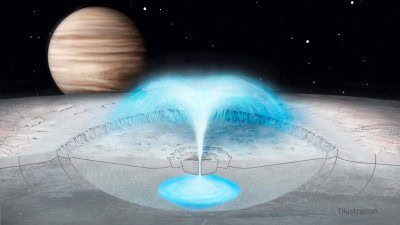Washington, Nov 15 : Plumes of water vapour that may be venting into space from Jupiter’s moon Europa could come from within the icy crust itself, according to new research.
A model using images collected by NASA’s Galileo spacecraft outlines a process for brine, or salt-enriched water, moving around within the moon’s shell and eventually forming pockets of water –even more concentrated with salt — that could erupt.
“Understanding where these water plumes are coming from is very important for knowing whether future Europa explorers could have a chance to actually detect life from space without probing Europa’s ocean,” said lead author Gregor Steinbrugge, a postdoctoral researcher at Stanford University’s School of Earth, Energy and Environmental Sciences.
Scientists have considered the possible plumes on Europa a promising way to investigate the habitability of Jupiter’s icy moon, especially since they offer the opportunity to be directly sampled by spacecraft flying through them.
The insights into the activity and composition of the ice shell covering Europa’s global, interior ocean can help determine if the ocean contains the ingredients needed to support life.
The source of the plumes is important: Water originating from the icy crust is considered less hospitable to life than the global interior ocean because it likely lacks the energy that is a necessary ingredient for life.
In Europa’s ocean, that energy could come from hydrothermal vents on the sea floor.
The results, published in Geophysical Research Letters, may shed light on eruptions on other icy bodies in the solar system.
The researchers focused their analyses on Manannan, a 29-km-wide-crater on Europa that resulted from an impact with another celestial object tens of millions of years ago.
“The comet or asteroid hitting the ice shell was basically a big experiment which we’re using to construct hypotheses to test,” said co-author Don Blankenship, senior research scientist at the University of Texas Institute for Geophysics (UTIG).
“Our model makes specific predictions we can test using data from the radar and other instruments on Europa Clipper,” said Blankenship, also principal investigator of the radar instrument that will fly aboard NASA’s upcoming Europa Clipper spacecraft.
The model indicates that as Europa’s water partially froze into ice following the impact, leftover pockets of water could have been created in the moon’s surface.
These salty water pockets can move sideways through Europa’s ice shell by melting adjacent regions of ice and consequently become even saltier in the process.
Missions such as Europa Clipper help contribute to the field of astrobiology, the interdisciplinary research on the variables and conditions of distant worlds that could harbour life as we know it.
Disclaimer: This story is auto-generated from IANS service.

